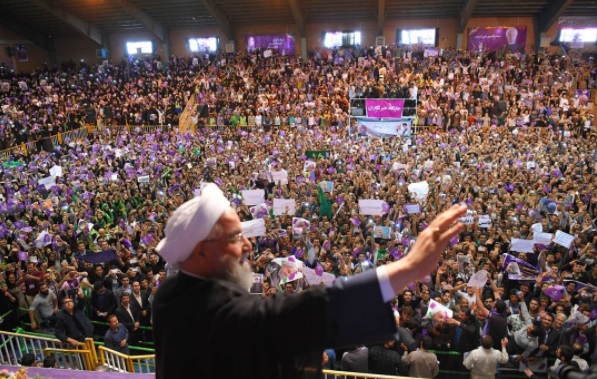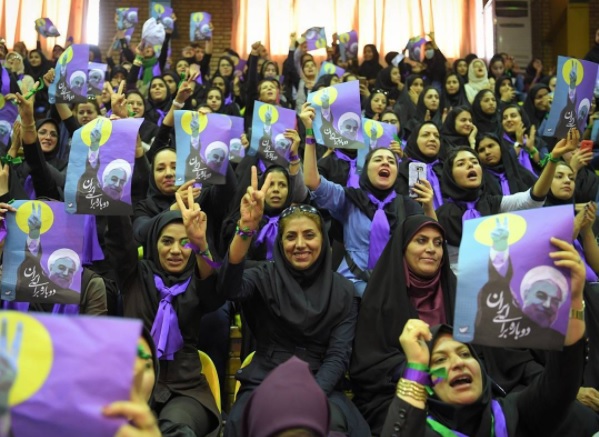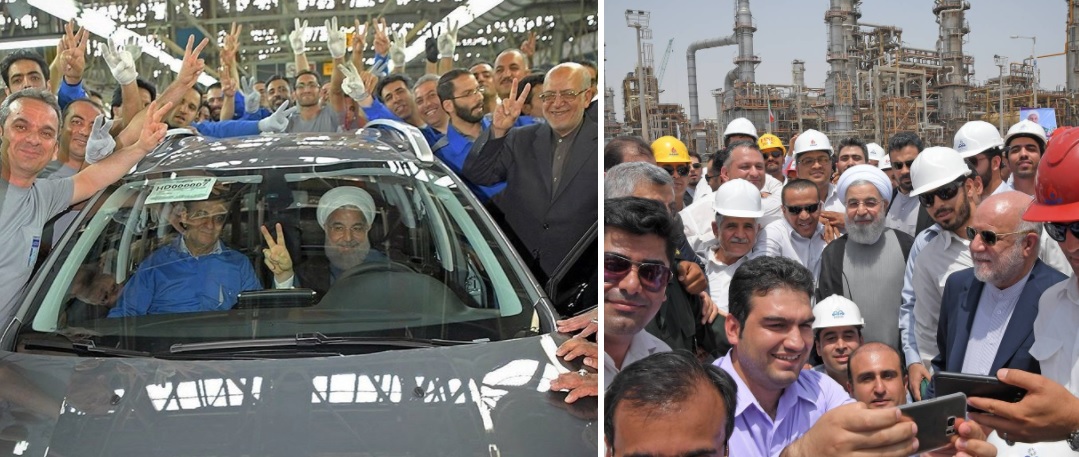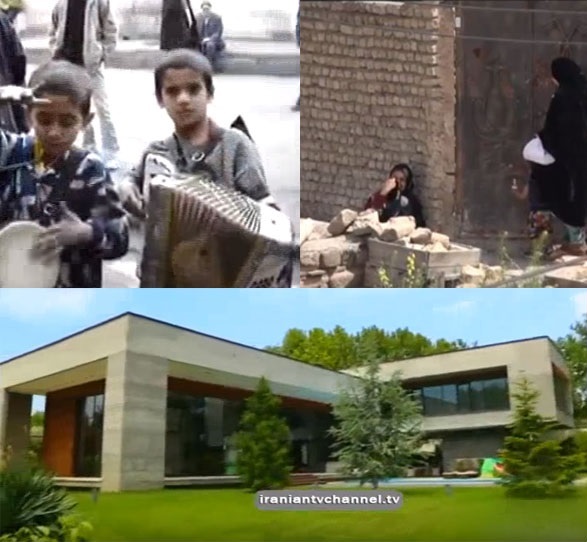 Iran’s presidential campaign has gone from feisty to combative. President Hassan Rouhani has dared to rebuke his rivals and even scolded hardline clerics and the powerful Revolutionary Guards. At campaign rallies and in television debates, he has presented the election as a stark choice between freedom and suppression. He chastised other candidates for hypocrisy. “We’ve entered this election to tell those practicing violence and extremism that your era is over,” he said on May 8. “The people of Iran shall once again announce that they don’t approve of those who only called for executions and jail throughout the last 38 years.”
Iran’s presidential campaign has gone from feisty to combative. President Hassan Rouhani has dared to rebuke his rivals and even scolded hardline clerics and the powerful Revolutionary Guards. At campaign rallies and in television debates, he has presented the election as a stark choice between freedom and suppression. He chastised other candidates for hypocrisy. “We’ve entered this election to tell those practicing violence and extremism that your era is over,” he said on May 8. “The people of Iran shall once again announce that they don’t approve of those who only called for executions and jail throughout the last 38 years.”
A poll conducted on May 7 and 8 showed Rouhani in the lead, but his rivals have started to close the gap. Conservative cleric Ebrahim Raisi was just 15 points behind the incumbent, and Tehran Mayor Mohammad Bagher Qalibaf trailed by only 17 points, according to the Iranian Students Polling Agency. No one scored over fifty percent. If no candidate wins a clear majority, Iran will hold a run-off between the top two. Together, the two conservatives tallied over half the vote while Rouhani had support from under 42 percent of voters. The top two candidates have taken their campaigns to outlying provinces and have used social media extensively to reach out to Iran’s 55 million eligible voters.

**Update: On May 15, Qalibaf dropped out of the race to support Raisi. Jahangiri later dropped out to support Rouhani.
President Hassan Rouhani
 Rouhani’s campaign is built partly on attacking conservative candidates for human rights abuses and hypocrisy. At a May 7 rally, he said, “Those who cut tongues and sew lips are talking about freedom of expression and criticism. Your only expression in recent years has been the word ‘prohibition’: prohibition of pens, prohibition of images.”
Rouhani’s campaign is built partly on attacking conservative candidates for human rights abuses and hypocrisy. At a May 7 rally, he said, “Those who cut tongues and sew lips are talking about freedom of expression and criticism. Your only expression in recent years has been the word ‘prohibition’: prohibition of pens, prohibition of images.”
“Your logic is prohibition and nothing else. Our young people have chosen the path of freedom,” Rouhani said, referring to his challengers. He may have been alluding to Ebrahim Raisi, a former attorney general and alleged member of the so-called ‘death commission’ that oversaw the 1988 mass execution of political prisoners, or Mohammad Bagher Qalibaf, who was involved in the 1999 crackdown on student protestors.
Rouhani has even dared to challenge other branches of government over the open-ended detention of two presidential candidates—former Prime Minister Mir Hossein Mousavi and former Parliamentary Speaker Mehdi Karroubi—in the disputed 2009 election. They have been under house arrest since 2011 for supporting the Green Movement protests that alleged fraud in the reelection of Mahmoud Ahmadinejad.
"Why have you confined to their houses our dear personalities who were of service to this nation... who showed Iran's real image to the world? Under what law?" Rouhani asked at the May 8 rally. "We will go to the ballot boxes on 19 May to bring back our noble men to society.” Rouhani also had promised to win the release of Mousavi and Karroubi in his 2013 campaign, but was unsuccessful.
Rouhani’s supporters have shouted the names of the two former opposition leaders at campaign rallies. He released a campaign ad that included the chants, but state media cut the scene from the video. The authorities view Mousavi and Karroubi as “seditionists” who were responsible for the mass protests following President Mahmoud Ahmadinejad’s reelection.
Rouhani rally felt more like a rally for Mousavi, crowd continually chanting Mir Hossein, Mir Hossein, who is currently under house arrest. pic.twitter.com/CXL16hu1Yy
— Ali Arouzi (@aliarouzi) May 9, 2017
Rouhani, a centrist, has won support from reformists. Mohammad Khatami, who was president from 1997 until 2005 and is now the figurehead of the reform movement, endorsed Rouhani. The media is not allowed to mention Khatami, and his appearance in public is curtailed by the authorities. But Rouhani supporters have also chanted Khatami’s name loudly at rallies.
 Rouhani has tried to tap into the standing of former President Hashemi Rafsanjani, who died in January 2017. He posted an Instagram photograph with Rafsanjani (middle) from the 1980-1988 war with Iraq, when Rouhani (left) headed Iran’s Central Command. The post reminded voters that Rouhani enjoyed the support of Rafsanjani, who was well-respected by reformers, centrists and pragmatic conservatives. Other campaign materials have also included Rafsanjani’s image.
Rouhani has tried to tap into the standing of former President Hashemi Rafsanjani, who died in January 2017. He posted an Instagram photograph with Rafsanjani (middle) from the 1980-1988 war with Iraq, when Rouhani (left) headed Iran’s Central Command. The post reminded voters that Rouhani enjoyed the support of Rafsanjani, who was well-respected by reformers, centrists and pragmatic conservatives. Other campaign materials have also included Rafsanjani’s image.
Rouhani has also focused on the women’s vote. “We won the [Islamic] revolution because women poured onto the streets. If women come to the polls today, we will win,” he said at a rally on May 9. At his campaign events, women have turned out in large numbers and cheered loudly. Rouhani has posted images of the female rally attendees on his Instagram account. Two have received more than 90,000 “likes” each.
During the first debate, Rouhani said that his government had already created more than 700,000 jobs for women and that he intends to do more for them. At a rally, he called out hardliners for their views on gender. “You don’t know them, I know them. They wanted to create segregated pavements the same way they issued a directive for sex segregation in their work place,” said Rouhani in a jab at Qalibaf, who reportedly tried to segregate city council offices.
 Rouhani has also reached out to ethnic and religious minorities. About two-thirds of Iran’s population is Persian, and about 90 percent is Shiite. In the second presidential debate, Rouhani said that minorities do not yet enjoy the same rights as other Iranians. He noted that his government was attacked for appointing a Sunni woman as a governor. A Sunni lawmaker claimed that none of the other candidates, except Vice President Jahangiri, has ever defended minorities’ rights.
Rouhani has also reached out to ethnic and religious minorities. About two-thirds of Iran’s population is Persian, and about 90 percent is Shiite. In the second presidential debate, Rouhani said that minorities do not yet enjoy the same rights as other Iranians. He noted that his government was attacked for appointing a Sunni woman as a governor. A Sunni lawmaker claimed that none of the other candidates, except Vice President Jahangiri, has ever defended minorities’ rights.
During a visit to Hamedan, Rouhani discussed projects his government was working on that would benefit areas with large numbers of Kurds, a largely Sunni minority. “Our way is the way of peaceful co-existence of all religious sects,” he said.
Influential Sunni cleric Molavi Abdolhamid endorses Hassan Rouhani for President, calling on his fellow Sunni citizens to vote for Rouhani. pic.twitter.com/SDfIgPTyVz
— Sadegh Ghorbani (@GhorbaniSadegh) May 6, 2017
Rouhani’s first official campaign video showed Intelligence Minister Mahmoud Alavi speaking Arabic with citizens complaining about the lack of schools and other services. The clip then highlighted environmental issues such as widespread droughts affecting areas with large Arab populations such Ahvaz.
Rouhani’s most positive message is that the economy is on the right track and that he is the most qualified to guide Iran for the next four years. He has been promoting the economic benefits of the nuclear deal, such as the opening or reopening of factories. On May 2, he launched the production line of a joint venture between French carmaker Peugeot and its local counterpart Iran Khodro. He posted a picture of himself in a car fresh off the line surrounded by factory workers on Instagram. In the caption, Rouhani pushed back on critics who said the nuclear deal is just a piece of paper and has not resulted in tangible benefits.

Rouhani also highlighted his administration’s economic success by attending the opening of the new “Star of the Persian Gulf” refining facility, which will help Iran become self-sufficient in gasoline production.
In the Instagram caption, Rouhani described how major pieces of equipment were purchased years ago but were not delivered because of international sanctions. The nuclear deal allowed Iran to import equipment and open the plant. He used the hashtag #If_there_wasn’t_JCPOA” (Joint Comprehensive Plan of Action).
Rouhani has acknowledged, however, that his administration has fallen short of expectations. “No, we didn’t reach the ideal [economic] conditions. We took steps in this direction,” he said in his campaign video.
Ebrahim Raisi
Raisi’s campaign has been based largely on challenging the shortcomings of Rouhani’s government. “Today, 30 percent of our young people are out of jobs and unemployment is over 12 percent,” he told supporters at a Tehran stadium on April 29. “We are facing an unacceptable situation because of weak management.”
Raisi has argued that Rouhani’s government has been ineffective. “If this administration keeps creating jobs at the current rate, it will take 10 years to solve the unemployment problem [not accounting for new jobseekers],” he said during a May 11 television program. Raisi has gone after Rouhani for insisting that foreign investment is necessary for significant job creation. “Does this situation have to continue? Do we have to wait for foreigners to fix our problems?” he asked at a rally.
Raisi has derided the government for wasting Iran’s domestic potential. “Every day, we are seeing workshops and factories closing down. Fifty percent of the country’s industrial capacity is not active,” he said on a May 11 television program. He also claimed that Chinese imports have doubled under Rouhani while domestic production has fallen.
Raisi’s main campaign ad portrayed him as the champion of the common people. The 30-minute clip highlighted the growing gap between rich and poor. It juxtaposed images of street children and crumbling houses with villas and Western-style apartments.
 In the video, Raisi visited working class neighbors to hear about citizens’ needs. One man said he has no health insurance or income. “I want to save people from this situation,” Raisi said. High levels of unemployment and poverty are not “dignified.” Throughout the campaign, he has used slogans including “change for the people’s interests” and “the people are tired of this situation.”
In the video, Raisi visited working class neighbors to hear about citizens’ needs. One man said he has no health insurance or income. “I want to save people from this situation,” Raisi said. High levels of unemployment and poverty are not “dignified.” Throughout the campaign, he has used slogans including “change for the people’s interests” and “the people are tired of this situation.”
Raisi has also gone after Rouhani’s negotiations with the United States and other Western powers. In the second debate, Raisi questioned Rouhani’s ability to ensure other countries fulfill their commitments under the nuclear deal. “You failed to cash the nuclear deal check. To cash this check, we need a strong and tough government.” Anti-Western sentiment has been palpable at Raisi’s rallies. “We don’t want an American government,” his supporters chanted at an April 30 event (see video below). It was likely a jab at Rouhani’s largely U.S.-educated cabinet. Raisi supporters have also chanted “death to the U.S.” Conservatives fear the return of U.S. influence in Tehran.
الان، شعار یکصدای حامیان #رئیسی علیه #روحانی در حاشیه سخنرانی رئیسی در #قزوین: «دولت آمریکایی نمیخواهیم» pic.twitter.com/NJ4TbTgsfp
— Alireza Mataji (@alimat1979) April 30, 2017
Raisi has close ties to Supreme Leader Ayatollah Ali Khamenei and is rumored to be a potential successor to the 77-year-old. Khamenei said he will not endorse a candidate, but Raisi has earned the support of other senior clerics. The Society of Qom Seminary Teachers, an influential clerical organization, endorsed him on May 2. Raisi holds a respected position among the clerical establishment. As Custodian of Astan Quds Razavi, he is responislbe for maintaining the shrine of Imam Reza in Mashhad, the most holy site in Iran for Shiite Muslims.
Raisi also has reached out to ethnic and religious minorities. On May 2, the Shiite cleric met with Sunni clerics in Kurdistan Province and warned against thinking in terms of “us and you.” He said all Iranians are together. Raisi noted the untapped potential of Kurdistan in remarks to state media. “It is unacceptable that given the rich and valuable wealth and resources in this region, the young people of this area have difficulty finding jobs. That is unacceptable for us,” he said.
Iranian presidential candidate Ibrahim Raisi, main rival to incumbent president, has visited Kurdistan province in #Iran. pic.twitter.com/bKDhTDAkY6
— Rudaw English (@RudawEnglish) May 5, 2017
On May 6, he told Sunni clerics in Tehran that he would address concerns of both Sunni and Shiite clerics if elected. On May 9, Raisi visited Zahedan, the capital of Sistan-e Baluchestan province and home to a large Baluch population, a predominantly Sunni minority.
 Raisi has pledged to fight corruption if elected. “In my administration, there will be no inflated salaries and injustice,” he said on May 11. The cleric has attempted to differentiate himself from wealthy officials. “Except for a personal home that is a 140-meter apartment and one bank account, I don’t have anything else,” he said in a May 8 interview with Tasnim. The graphic here included a pledge to increase government transparency by releasing reports on corruption.
Raisi has pledged to fight corruption if elected. “In my administration, there will be no inflated salaries and injustice,” he said on May 11. The cleric has attempted to differentiate himself from wealthy officials. “Except for a personal home that is a 140-meter apartment and one bank account, I don’t have anything else,” he said in a May 8 interview with Tasnim. The graphic here included a pledge to increase government transparency by releasing reports on corruption.
